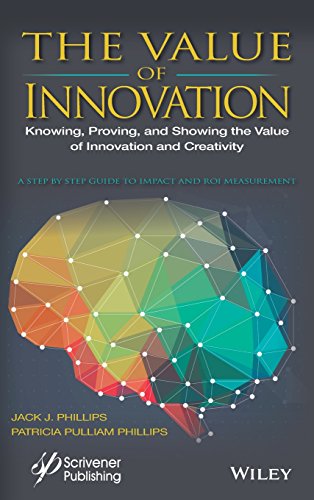The value of innovation knowing proving and showing the value of innovation and creativity a step by step guide to impact and ROI measurement 1st Edition by Jack Phillips, Patricia Pulliam Phillips ISBN 978-1119242376 1119242371
$50.00 Original price was: $50.00.$25.00Current price is: $25.00.
The value of innovation knowing proving and showing the value of innovation and creativity a step by step guide to impact and ROI measurement 1st Edition by Jack J. Phillips, Patricia Pulliam Phillips – Ebook PDF Instant Download/Delivery: 978-1119242376, 1119242371
Full download The value of innovation knowing proving and showing the value of innovation and creativity a step by step guide to impact and ROI measurement 1st Edition after payment

Product details:
ISBN 10: 1119242371
ISBN 13: 978-1119242376
Author: Jack J. Phillips, Patricia Pulliam Phillips
Innovation is the life blood of practically every organization. Innovation drives growth, development, and prosperity for many organizations and geographical areas. Sometimes, innovation thrives within a certain geographical location or in certain organizations that are known for their innovative approaches. This outstanding new volume will demonstrate how to measure the success of innovation in all types of organizations.
In the last decade, there have been tremendous investments in creativity and innovations sponsored by companies, cities, states, countries, universities, NGO’s, and even non-profits. With the magnitude of emphasis on creativity and innovation, the sponsors and key stakeholders will demand to know the value of these programs. The Value of Innovation: Measuring the Impact and ROI in Creativity and Innovation Programs will show step-by-step how to measure the impact and the ROI of innovation and creativity programs. The process collects six types of data: reaction, learning, application, impact, ROI, and intangibles. Data are collected analyzed and reported using a systematic, logic model. Conservative standards create results that are both CEO and CFO friendly. This proven process has been used now in 5000 organizations and this new book adapts the method directly to this critical area of innovation, showing examples and case studies.
Table of contents:
1 The Importance and Challenges of Innovation
Innovation Hype
Articles
Books
Jobs
Speeches
Experience
The Realities of Innovation
Innovation is Not New
Innovation is Necessary for Survival
Innovation is Equated with Success
Innovation is Truly Global
Consumers and Investors Expect Innovation
Innovation is Often Disruptive
Innovation is Not a Single Event
Little Ideas Often Make a Big Difference
Innovation Comes in Many Types and Forms
Innovation Spans Many Different Horizons
Trouble in Paradise: The Misconceptions
Misconception 1: Small Companies are More Innovative
Misconception 2: Uncontested Markets are Good for Innovation
Misconception 3: Spending More on R&D Increases Innovation
Misconception 4: Companies Need More Radical Innovation
Misconception 5: Open Innovation Turbocharges R&D
Misconception 6: R&D Needs to be More Relevant
Misconception 7: Wall Street Rewards Innovation
Innovation Challenges
Innovation is Expensive
Managing Innovation is Difficult
An Innovation Culture is Necessary for Success
Innovation Requires Many Personas
Innovation Success Rates Need to Improve
The Value of Innovation is Unclear
Final Thoughts
2 Status and Concerns about Innovation Measurement
Innovation: Definition, Models, and Measures
Sources of Innovation
Measurement Shifts
Value Perception
The Search for Money
Hoping, Knowing, Proving, and Showing Value
Innovation is Systematic
Macro View of Measurement
Industry Level Measures
Company Level
Concerns about Company Level Measures
Micro View of Measurement
Final Thoughts
3 The Case for a New System
Innovation: A Cost or an Investment?
The Value of Innovation: A Summary
Intangibles and the Fear of not Investing
Relationship Between Variables
ROI Studies
Types of Data
Inputs
Reaction and Planned Action
Learning
Application and Implementation
Impact
Return on Investment
How Does Your Current System Stack Up?
Focus of Use
Standards
Types of Data
Dynamic Adjustments
Connectivity
Approach
Conservative Nature
Simplicity
Theoretical Foundation
Acceptance
Using Design Thinking to Deliver and Measure Results
Start with Why
Make it Feasible
Expect Success
Make it Matter
Make it Stick
Make it Credible
Tell the Story
Optimize the Results
Requirements for the Value of Innovation
ROI Measurement Methodology
Terminology
Final Thoughts
4 Introducing the ROI Methodology
The ROI Methodology
Types of Data
The Initial Analysis
The ROI Process Model
Planning the Evaluation
Collecting Data
Isolating the Effects of the Project
Converting Data to Monetary Values
Identifying Intangible Benefits
Tabulating Project Costs
Calculating the Return on Investment
Reporting
Operating Standards and Philosophy
Implementing and Sustaining the Process
Benefits of This Approach
Final Thoughts
5 Aligning Innovation Projects to the Organization
Creating Business Alignment
The Purpose of Alignment
Disciplined Analysis
Determining the Potential Payoff
Determining Business Needs
Determining Performance Needs
Determining Learning Needs
Determining Preference Needs
Case Study: Southeast Corridor Bank
Developing Objectives for Innovation Projects
Final Thoughts
6 Collecting Data Along Chain of Impact with a Toolbox of Methods
Questionnaires and Surveys
Using Interviews
Using Focus Groups
Measuring with Tests
Measuring with Simulation
Using Observation
Using Action Plans
Using Performance Contracts
Monitoring Business Performance Data
Selecting the Appropriate Method for Each Level
Final Thoughts
7 Measuring Reaction and Perceived Value
Why Measure Reaction and Perceived Value?
Sources of Data
Areas of Feedback
Data Collection Timing and Methods
Using Reaction Data
Final Thoughts
8 Measuring Learning
Why Measure Learning and Confidence?
The Importance of Intellectual Capital
The Role of Learning in Innovation Projects
Challenges and Benefits of Measuring Learning
Measurement Issues
Administrative Issues
Using Learning Data
Final Thoughts
9 Measuring Application and Implementation
Why Measure Application and Implementation?
Problems and Opportunities
Measurement Issues
Data Collection Methods
Using Action Plans
Application Data Use
Final Thoughts
10 Measuring Impact
Why Measure Business Impact?
Collecting Effective Impact Measures
Metric Fundamentals
Business Performance Data Monitoring
Using Action Plans and Performance Contracts
Measuring the Hard to Measure
Final Thoughts
11 Isolating the Effects of Innovation
Why the Concern?
Preliminary Issues
Isolation Methods
Estimate Credibility
Calculate the Impact of Other Factors
Final Thoughts
12 Converting Data to Money
Why Convert Data to Monetary Values?
Key Steps
Converting Output and Quality Data
Using Historical and Expert Estimates
Finalizing Value
Final Thoughts
13 Addressing Intangibles
Why Intangibles are Important
Measuring and Analyzing Intangibles
Final Thoughts
14 Measuring ROI
Why Monitor Costs and Measure ROI?
Fundamental Cost Issues
ROI Calculation
Other ROI Measures
Final Thoughts
15 Forecasting Value, Including ROI
Why Forecast ROI?
Forecasting Approaches
Forecasting Guidelines
Final Thoughts
16 Reporting Results
The Importance of Communicating Results
Principles of Communication
The Communication Plan
Delivering the Message
Final Thoughts
17 Implementing and Sustaining ROI
Why is this Important?
Overcoming Resistance
Developing Roles and Responsibilities
Using ROI as a Learning Tool
Initiating ROI Studies
Monitoring Progress
Final Thoughts
References
Index
People also search for:
the value of innovation
the principles of innovation are largely focused on profit maximization
the value of not knowing
the innovation and learning perspective
a value innovation strategy requires
You may also like…
Medicine
The Easy Guide to OSCEs for Specialties a Step By Step Guide to Success Second Edition Akunjee
Religion & Spirituality - Theosophy & New Age
Medium a step by step guide to communicating with the spirit world First Edition Star
Housekeeping & Leisure - Gardening
Beginner Gardening Step by Step A Visual Guide to Yard and Garden Basics 1st Edition Emma Tennant
Arts - Graphic Arts
Business & Economics
The Innovation Revolution in Agriculture: A Roadmap to Value Creation Hugo Campos
Politics & Philosophy
A Step by Step Guide to Qualitative Data Coding 1st Edition Philip Adu 1351044494 9781351044493











